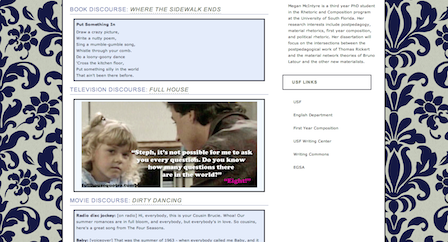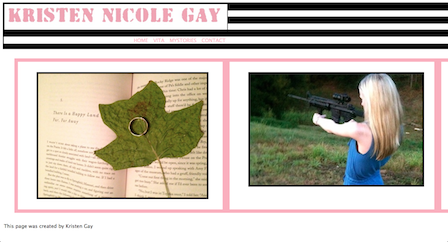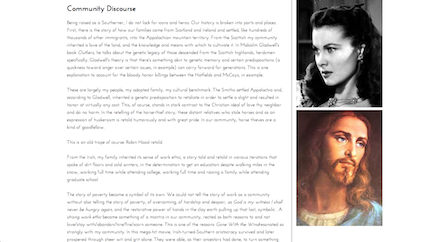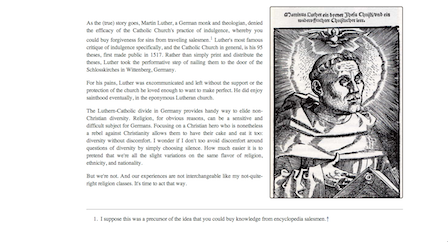Our [Electrate] Stories
Explicating Ulmer's Mystory Genre
Marc C. Santos, Ella R. Bieze, Lauren E. Cagle, Jason C., Zachary P. Dixon, Kristen N. Gay, Sarah Beth Hopton, Megan M. McIntyre
3. Does the mystory realize Ulmer’s aspirations?
Our attempts at answering this question necessarily began with an exploration of how we understood Gregory L. Ulmer’s aspirations. While we all recognized Ulmer’s electracy as a move away from literacy, some of us saw the mystory project as more focused on the individual, while others saw the project as more focused on the social. Lauren E. Cagle put our collective understanding of Ulmer’s call for electracy nicely when she described it as “a development beyond literacy,” and Jason C. described the project similarly, explaining it as a call “to reflect on the implications of electracy in [the rhetor’s] own life and to explore and invent new modes (for instance, this gestalt map as a new mode) in the process.”
Focusing on the act of composing online, Megan M. McIntyre explained, “Coding attractive web pages is not the goal of composing a mystory; rather, Ulmer uses the double–disorientation of Internet Invention’s (2003) complex theoretical content and the unfamiliar syntax of HTML and CSS to force writers into new territory.” In her reflections, McIntyre identified this double-disorientation as a focal point of her experience with the mystory:
Though many of the punctum moments come in my Career and Family discourses, my favorite pages are the ones in my Entertainment Discourse. Part of this is nostalgic: I still remember how much I loved Where the Sidewalk Ends and how much I wanted to be part of the family on Full House. Mostly, though, my love for these pages has to do with the ways in which my text mixed with text, images, and videos from my favorite book, television show, and movie. I find this mixture interesting theoretically because of the ways in which the message of each component depends on the others for meaning(s). But I also think that composing these pages was the moment I realized how composing for the web (because of the affordances of images, videos, hyperlinks, etc.) altered my conception of composition broadly. Network technolgies have fundamentally altered the way that things are written and read in digital spaces. And I can do so much on the web that I can’t do with pen (or word processing program) and paper.
So, unlike the explication offered earlier in this webtext, participants’ reflections echo McIntyre by primarily framing electracy as utilizing new spaces, tools, and methods. Beyond these new notions of electracy, however, our understandings of Ulmer’s aspirations differ slightly, and because of that, our interpretations of how the mystory realizes those aspirations also differ.
While individual interpretations of Ulmer’s exact goal differ somewhat, all agreed that elements of the mystory were at least partially successful. For McIntyre, Ulmer’s goal is “to give students the tools to do exploratory surgery of sorts: the mystory asks you to open old wounds in order, hopefully, to give you insight into the broader patterns of your life.” She believes Ulmer achieves his socio–expressivist goal. Similarly, Kristen N. Gay found that the mystory successfully “helps egents confront themselves as troubled and limited.” Ella R. Bieze, too, saw the mystory as focused on the “self,” on the individual. She reflected after creating her mystory, “something has changed, or become clearer, or become more complicated; our notions of our own subjectivity have shifted, and that shift is the work of the mystory.” Sarah Beth Hopton, too, understands the mystory project’s goal as a social one. She sees Ulmer’s aspirations as encouraging “students to look at the relationship of the self to the social forces moving through language that in turn shape the self.”
Several participants, while appreciating the mystory’s personal reflecton, question the extent to which it offers a radically different digital pedagogy, wondering if it is not, in the end, too committed to forms of literacy it hopes to surpass. Zachary P. Dixon saw Ulmer’s aspirations as potentially two different things: (1) an individual “aesthetic, poetic, and artistic exercise” and (2) an attempt at creating “a pedagogical exercise that challenges the paradigm of literacy as the primary mode of expressing, communicating, and relating to knowledge.” He felt the mystory accomplished its former aim, but ultimately failed at the latter:
Despite the mystory’s radical reappropriation of the image and design to embrace alternative narrative structure, I think that Ulmer ultimately fails to provide students with the tools to break out of the mold. I can see how students could simply reproduce the same constraints of literacy in electracy. (Dixon)
Cagle, focusing on the way she needed to use text in addition to images in constructing her mystory, agreed, saying, “Given this prevalence of text, how do our mystories move away from literacy, literally understood? While I’m not prepared to argue that they don’t, it remains unclear how and how much they do.” For some participants the project does not go far enough:
While Ulmer’s focus on a punctum, emotively driven articulation of knowing-by-feeling, is promising, I feel like the mystory does not do the necessary groundwork of exposing and challenging the root of the mind body split that represents a core problem of literacy. (Dixon)
Jason C. questioned the value of the mystory, questioning whether it transfers to other projects or whether it simply helps “creation of another mystory.” Hopton and Cagle both questioned how to enact the social-ness of the mystory genre. As we mentioned in our explication of electracy, participants wondered whether the mystory did all it could to take advantage of digital affordances of connectivity. In particular, as previously noted, many participants believe the mystory eschewed the inherently social nature of the web in favor of personal exploration.
Cagle raised another criticism worthy of review. She wrote, “on the subject of the immediate response in the moment of reading, however, Ulmer stays silent; he provides no guidance as to how to respond to the personal and affective memories shared throughout the mystory.” As we address more extensively in our review of question 4, participants questioned whether Ulmer provided the necessary resources for adequately dealing with the intense, sometimes even traumatic, emotional material the mystory unearths. From this perspective, the mystory might work too well; it stings too hard.
Although some participants had doubts about the mystory’s realization of Ulmer’s aspirations, many saw the mystory as an important step in redefining what kind of writing we consider valuable, both as individuals and as academics. Gay noted, “It was refreshing to do a project that asked me to write about personal, situated experiences/knowledges that I have collected over the years . . . I want the moments in writing when we can stop philosophizing, and criticizing, and juxtaposing.” Dixon agreed, writing, “I found the opportunity (and the call) to create something that was not directly tied to value-as-product very enjoyable and beneficial.” Hopton explained, “If nothing else, I like this kind of deep reflection and the writing it produces,” musing that “perhaps the mystory is the beginning of a hybrid discourse.” In the end, participants saw the mystory as a step in a new direction. While the mystory falls short in certain ways we have documented above, the project does realize Ulmer’s aspiration of opening and encouraging spaces for new institutions and ways of communicating.





